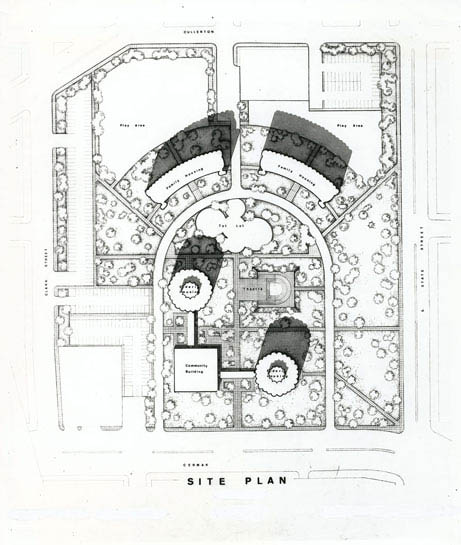02. Hilliard, Raymond, Homes. Site plan, c.1964-1965.
Clark, Cermak and State Streets; Chicago, IL, 1963-1966.
The Hilliard Homes, public housing for families and the elderly built for the Chicago Housing Authority (CHA), continue to be one of the most successful public housing projects constructed in Chicago, being the only project never to require uniformed police to keep order. Consisting of two 16-story towers of elderly housing and two 18-story arc-shaped towers for family housing, both groups of buildings were built without a structural concrete core. Instead, the outer walls consist of load-bearing, interlocking shells with elliptical windows designed to better distribute stresses on the building skin. As with Marina City, the widening dimensions of the rooms as one moves toward the windows gives the impression of greater interior volume than truly exists.
The success of the Hilliard Homes is not completely understood, but may at least be attributed in part to Goldberg's careful study of complex community relationships which informed many of his later designs—"Communication makes community," he once said. The core of each building was a community room to which the apartments fed, so that residents could intermingle and share. Social systems in the elderly units recall "the community life around a campfire" which our ancestors inhabited for millennia, and the circular form of Hilliard is Goldberg's "direct response to that kind of neighborhood."
On a broader level, the success of the Hilliard Homes may be attributed also to the fact that "the architecture gave a message that [the CHA had built] a community... and... simply weren't storing people, which has been the general message of [previous] public housing [projects]. Goldberg felt strongly that people who live in public housing should "not feel that because they are poor they are being punished." But it almost didn't happen. The bureaucrats in D.C. considered the plans were "too good for the poor" and that the designs would have been "better suited to a more artistic element of society." However, with the developer Chuck Swibel's help, Goldberg was able to retain his original design, about which he once said: "I didn't design for the poor, I designed for people."
"Architecture for Urbanism: Selections from the Bertrand Goldberg Archive," Case 3, Ryerson & Burnham Libraries, November 1, 2011–January 2, 2012
Link to R&B Archives Digital Collections record

